Identification of the Chemical Constituents in Aqueous Extract of Zhi-Qiao and Evaluation of Its Antidepressant Effect
Abstract
:1. Introduction
2. Results and Discussion
2.1. Optimization of LC and MS Conditions
2.2. Identification of Chemical Constituents in ZQ Aqueous Extract
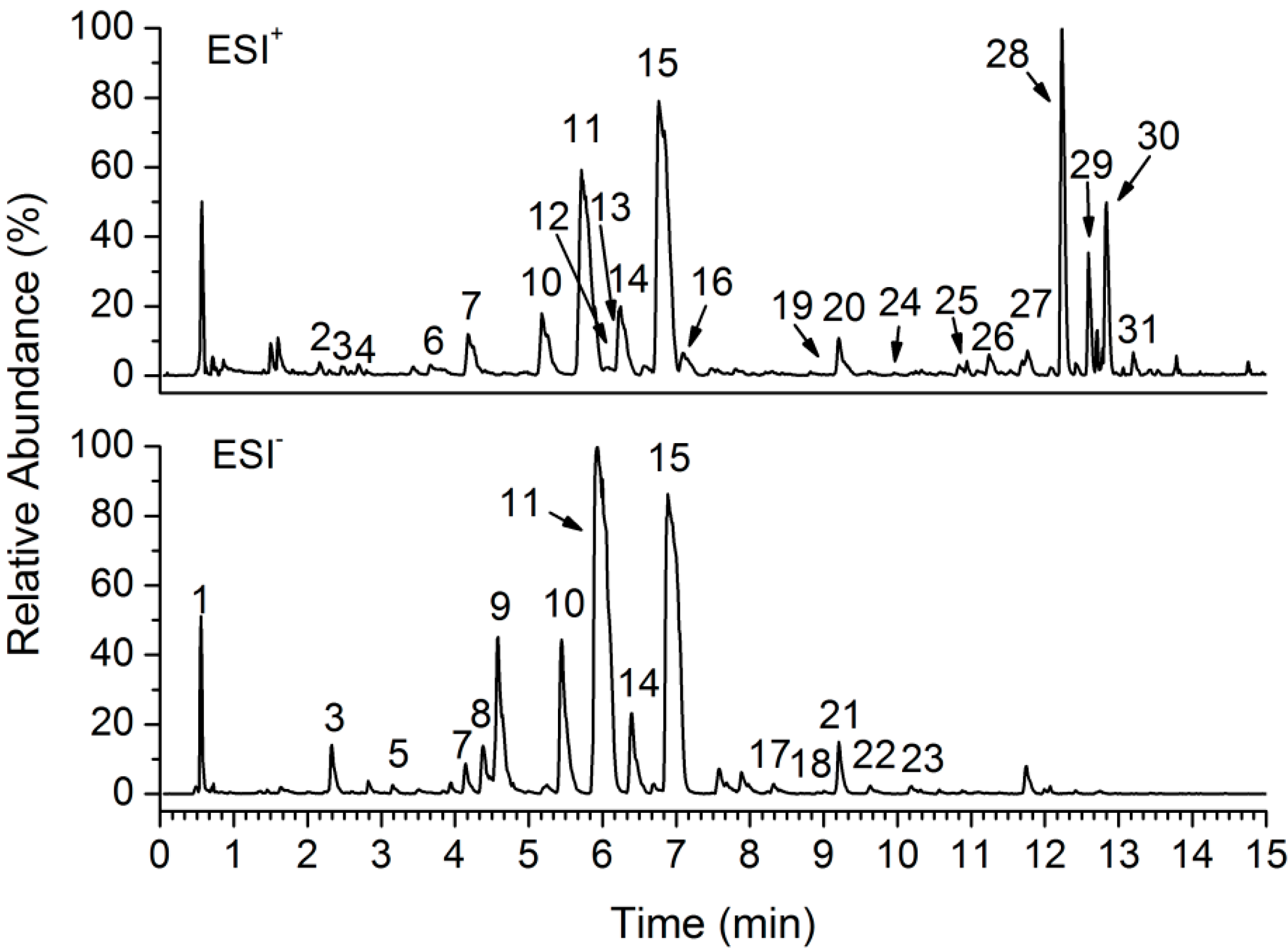
| Peak No. | Identification | Rt c (min) | Formula | Positive Ion Mode of ESI-MS (m/z) | Negative Ion Mode of ESI-MS (m/z) | ||
|---|---|---|---|---|---|---|---|
| Quasi-molecular ion | MS2 ions | Quasi-molecular ion | MS2 ions | ||||
| 1 | Quinic acid a | 0.55 | C7H12O6 | - | - | 191.0558 [M−H]− | 165.0363 |
| 2 | 6,8-Di-glucopyranocylapigenin b | 2.16 | C27H30O15 | 595.1670 [M+H]+ | 577.1560; 457.1149 | - | - |
| 3 | Isovitexin b | 2.39 | C21H20O10 | 433.1233 [M+H]+ | 379.0893; 367.0936; 313.1040 | 431.0986 [M−H]− | 353.1286 |
| 4 | Glucosyl-naringin b | 2.68 | C33H42O19 | 765.2200 [M+Na]+ | 625.1794; 581.1855; 539.1867 | - | - |
| 5 | Naringenin-7-O-triglycoside b | 3.15 | C33H42O19 | - | - | 741.2241 [M−H]− | 433.1134 |
| 6 | Naringenin-7-O-sophorose b | 3.71 | C27H32O15 | 597.1827 [M+H]+ | 435.1441; 417.1241; 199.1124 | - | - |
| 7 | Eriocitrin b | 4.18 | C27H32O15 | 597.1796 [M+H]+ | 289.0714; 179.0316; 163.0404 | 595.1669 [M−H]− | 287.0620 |
| 8 | Ichangin-4-O-β-d-glucopyranoside b | 4.38 | C32H42O14 | - | - | 649.2505 [M−H]− | 605.2636; 443.2061 |
| 9 | Neoeriocitrin b | 4.59 | C27H32O15 | - | - | 595.1658 [M−H]− | 459.1152 |
| 10 | Narirutin a | 5.19 | C27H32O14 | 603.1685 [M+Na]+ | 581.1850; 503.1530; 435.1188; 273.0711 | 579.1719 [M−H]− | 271.0622 |
| 11 | Naringin a | 5.71 | C27H32O14 | 603.1693 [M+Na]+ | 581.1850; 503.1530; 435.1188; 273.0711 | 579.1724 [M−H]− | 459.1138; 271.0649 |
| 12 | Meranzin-O-glucoside b | 5.84 | C21H28O10 | 463.1578 [M+Na]+ | 419.1343 | - | - |
| 13 | Rhoifolin b | 5.87 | C27H30O14 | 579.1698 [M+H]+ | 503.1538; 355.1575; 273.0760 | - | - |
| 14 | Hesperidin a | 6.25 | C28H34O15 | 633.1792 [M+Na]+ | 449.1434; 413.1336; 303.0869 | 609.1833 [M−H]− | 301.0723; 286.0500; 151.0063 |
| 15 | Neohesperidin a | 6.81 | C28H34O15 | 633.1794 [M+Na]+ | 449.1434; 413.1336; 303.0873 | 609.1816 [M−H]− | 489.1423; 343.0804; 301.0660 |
| 16 | Meranzin b | 7.09 | C15H16O4 | 261.1139 [M+H]+ | 189.0554 | - | - |
| 17 | 6,8-Di-glucopyranocyldiosmetin b | 8.25 | C28H32O16 | - | - | 623.1945 [M−H]− | 503.1146 |
| 18 | Neoponcirin b | 8.94 | C28H34O14 | - | - | 593.1899 [M−H]− | 285.0778 |
| 19 | Cyclo(-Gly-Leu-Val-Leu-Pro-Ser-) b | 9.20 | C27H46N6O7 | 589.3329 [M+Na]+ | 567.3504; 454.2654 | - | - |
| 20 | Kaempferol b | 9.25 | C15H10O6 | 287.0924 [M+H]+ | 239.2353 | - | - |
| 21 | Fumotonaringin b | 9.29 | C28H34O14 | - | - | 593.1853 [M−H]− | 285.0767 |
| 22 | Naringenin b | 9.63 | C15H12O5 | - | - | 271.0613 [M−H]− | 151.0041 |
| 23 | Hesperitin b | 10.19 | C16H14O6 | - | - | 301.0760 [M−H]− | 286.0501; 242.0572 |
| 24 | 3-Methoxynobiletin a | 10.24 | C22H24O9 | 433.1486 [M+H]+ | 403.1021; 373.0571 | - | - |
| 25 | Epoxybergamottin b | 10.85 | C21H22O5 | 355.1518 [M+H]+ | 344.0939 | - | - |
| 26 | Citrusin I b | 10.94 | C34H53N7O9 | 726.3782 [M+Na]+ | 704.3984 591.3105 | - | - |
| 27 | Isosinensetin b | 11.56 | C20H20O7 | 373.1264 [M+H]+ | 358.1040; 343.1270 | - | - |
| 28 | Nobiletin a | 12.23 | C21H22O8 | 403.1397 [M+H]+ | 383.1766; 239.1505 | - | - |
| 29 | Cyclo(-Gly-Gly-Leu-Leu-Leu-Pro-Pro-Phe-) b | 12.78 | C41H62N8O8 | 817.4586 [M+Na]+ | 795.4759; 682.3929; 399.2105 | - | - |
| 30 | Tangeretin a | 12.82 | C20H20O7 | 373.1288 [M+H]+ | 358.1063; 343.0814 | - | - |
| 31 | 7-Hydroxyl-4',3,5,6,8-pentamethoxy-flavone b | 13.20 | C20H20O8 | 389.1240 [M+H]+ | 374.1106; 359.0764; 197.0739 | - | - |
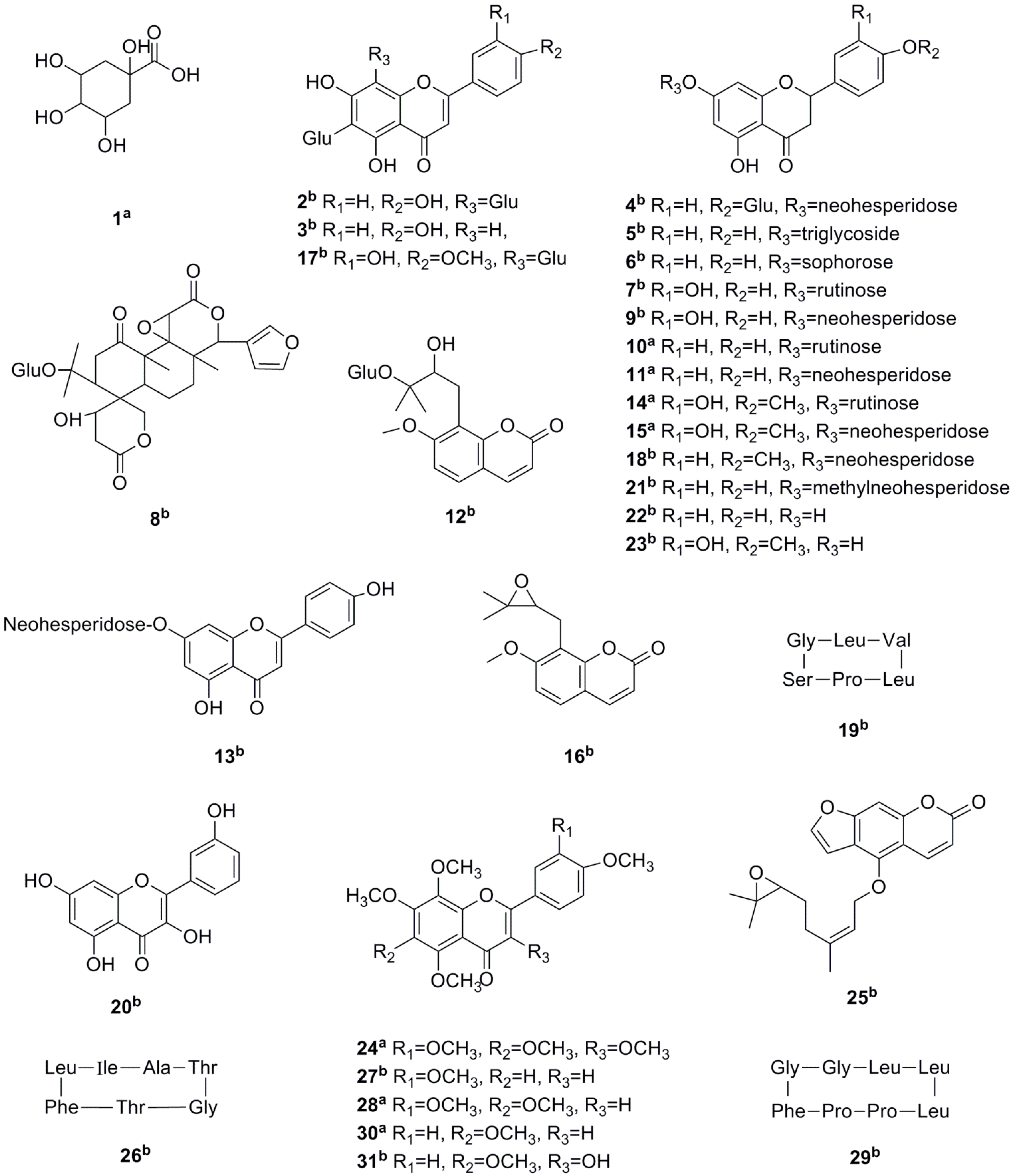
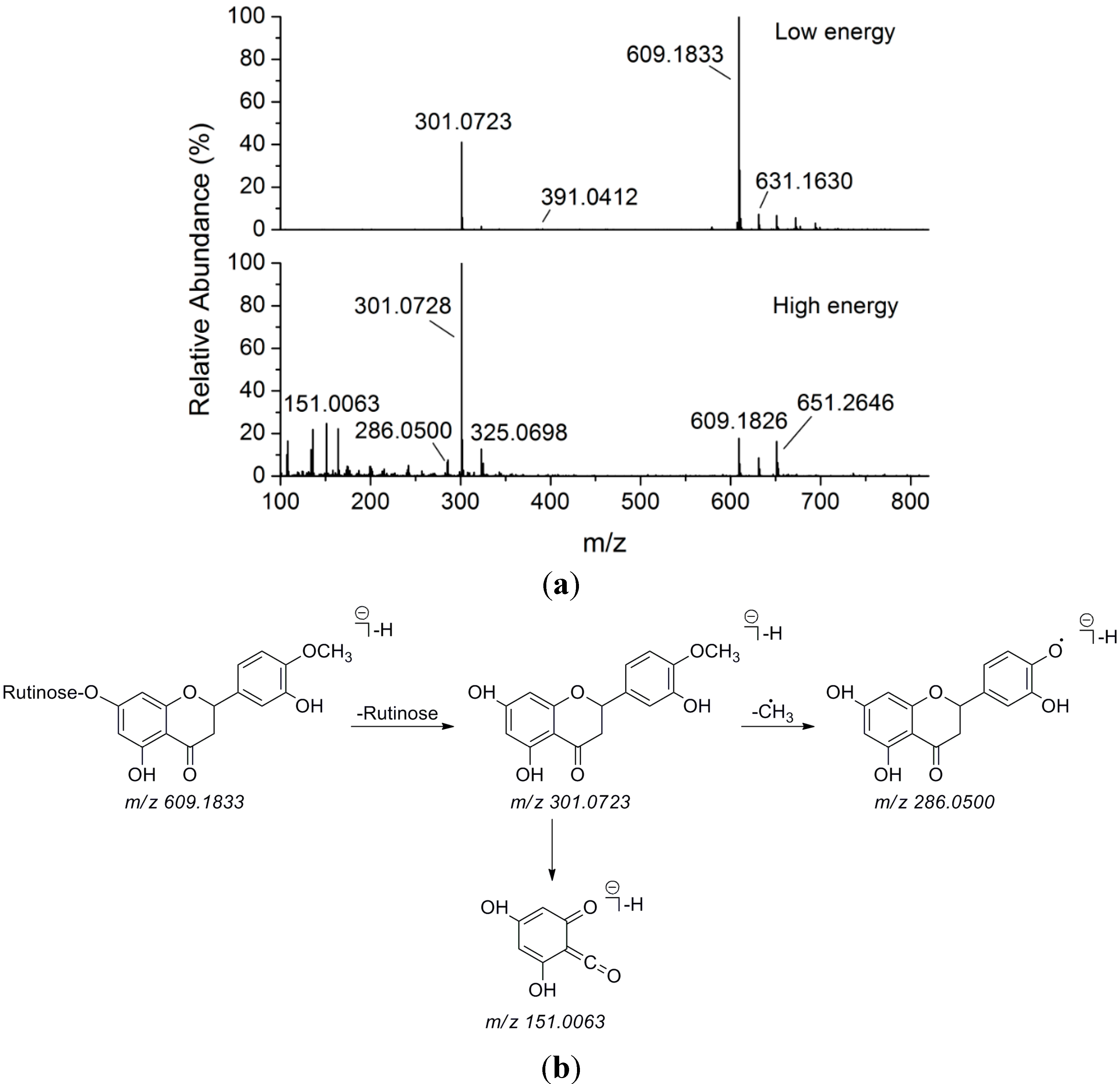
2.3. Effect of ZQ Aqueous Extract on Immobility Time in FST and TST
| Groups | FST | TST | ||
|---|---|---|---|---|
| Immobility Time (s) | Shorten Rate (%) | Immobility Time (s) | Shorten Rate (%) | |
| Vehicle | 79.2 ± 7.6 | 89.1 ± 9.4 | ||
| Clomipramine hydrochloride | 49.3 ± 7.6 ** | 37.8 | 52.5 ± 5.4 ** | 41.1 |
| ZQ | 55.2 ± 3.7 * | 33.3 | 41.1 ± 7.9 ** | 53.9 |
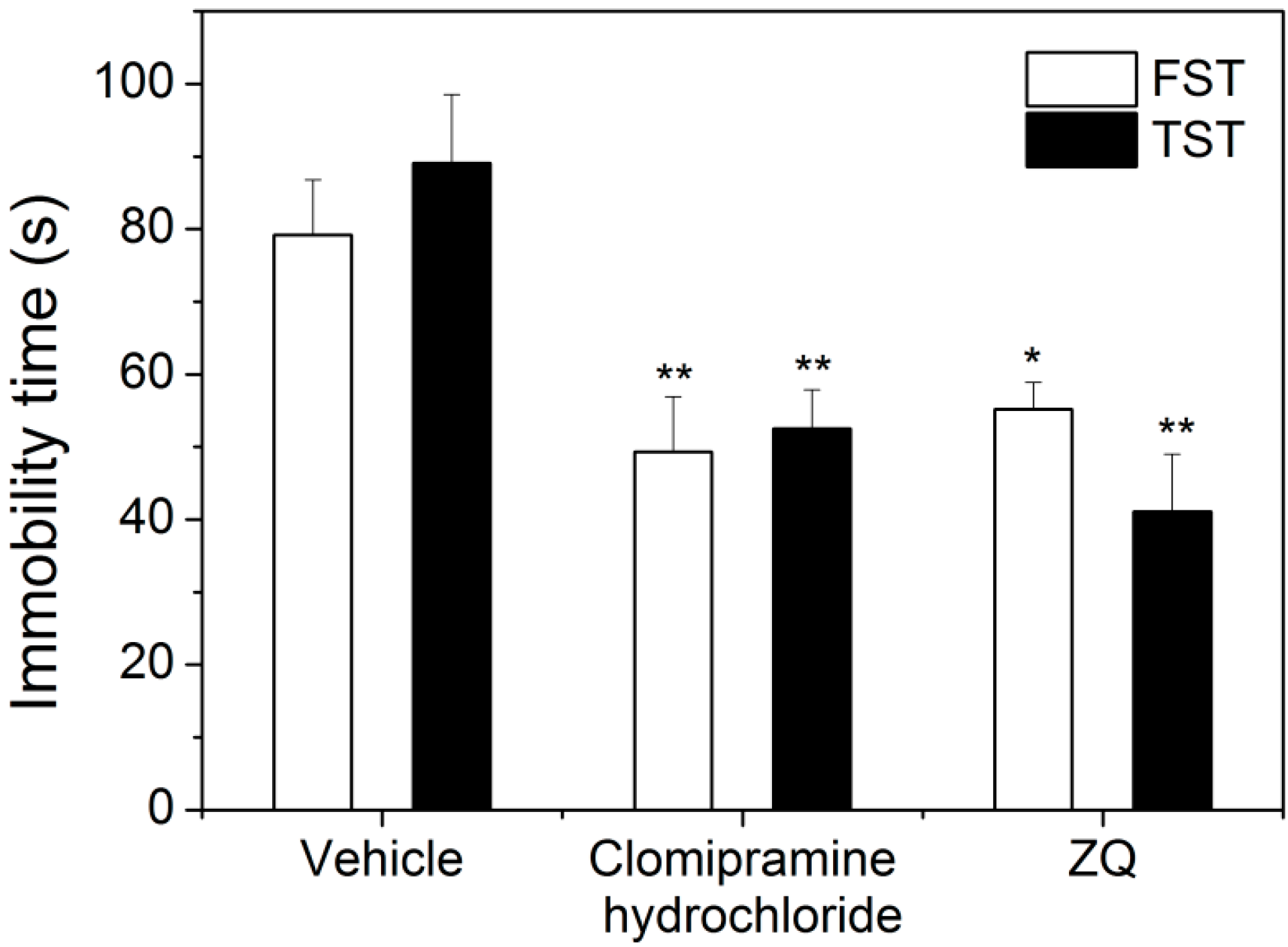
2.4. Neuroprotective Effect of ZQ Aqueous Extract on Corticosterone-Induced Neurotoxicity in PC12 Cells
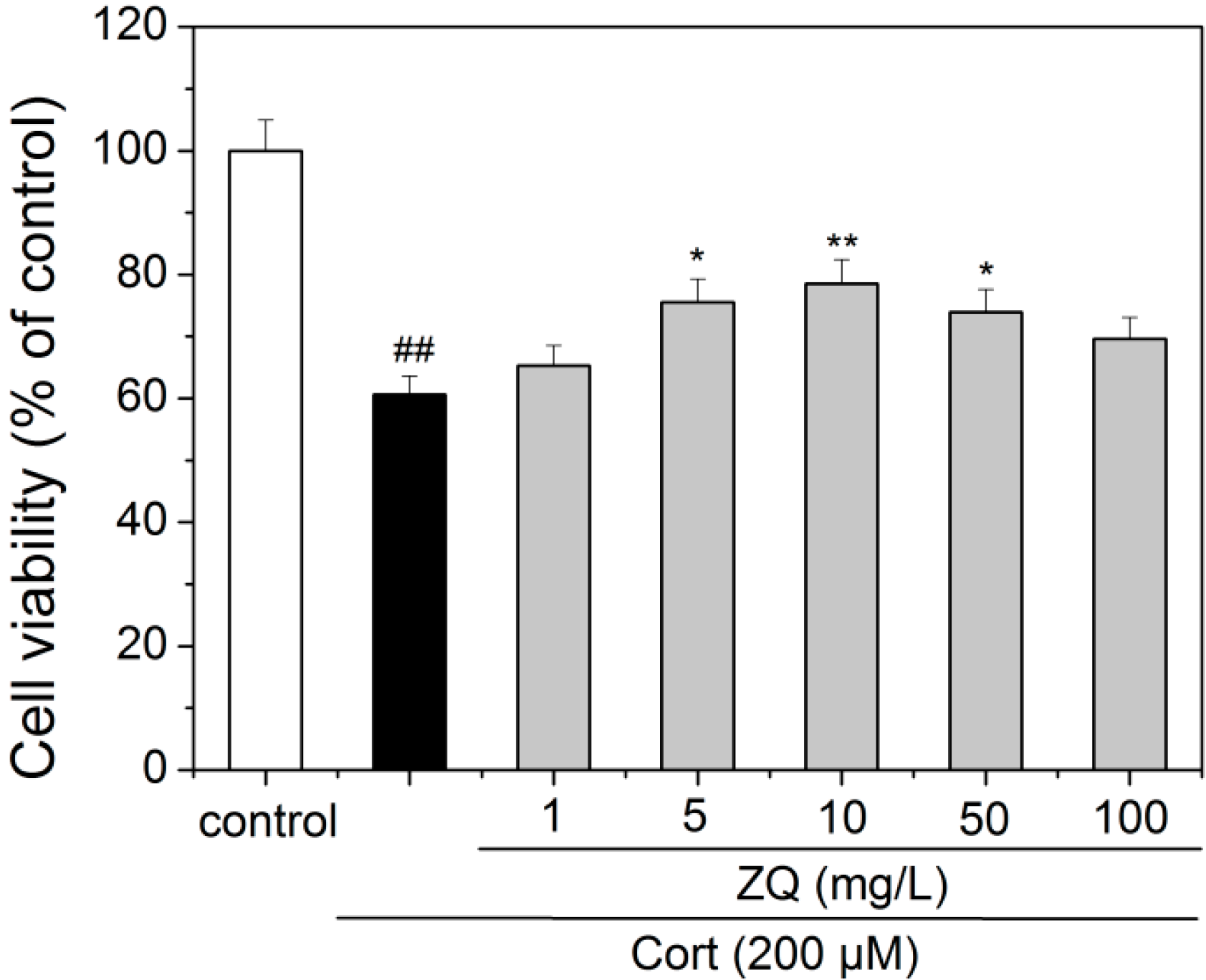
2.5. Neuroprotective Effect of Four Major Components in ZQ Aqueous Extract on Corticosterone-Induced Neurotoxicity in PC12 Cells
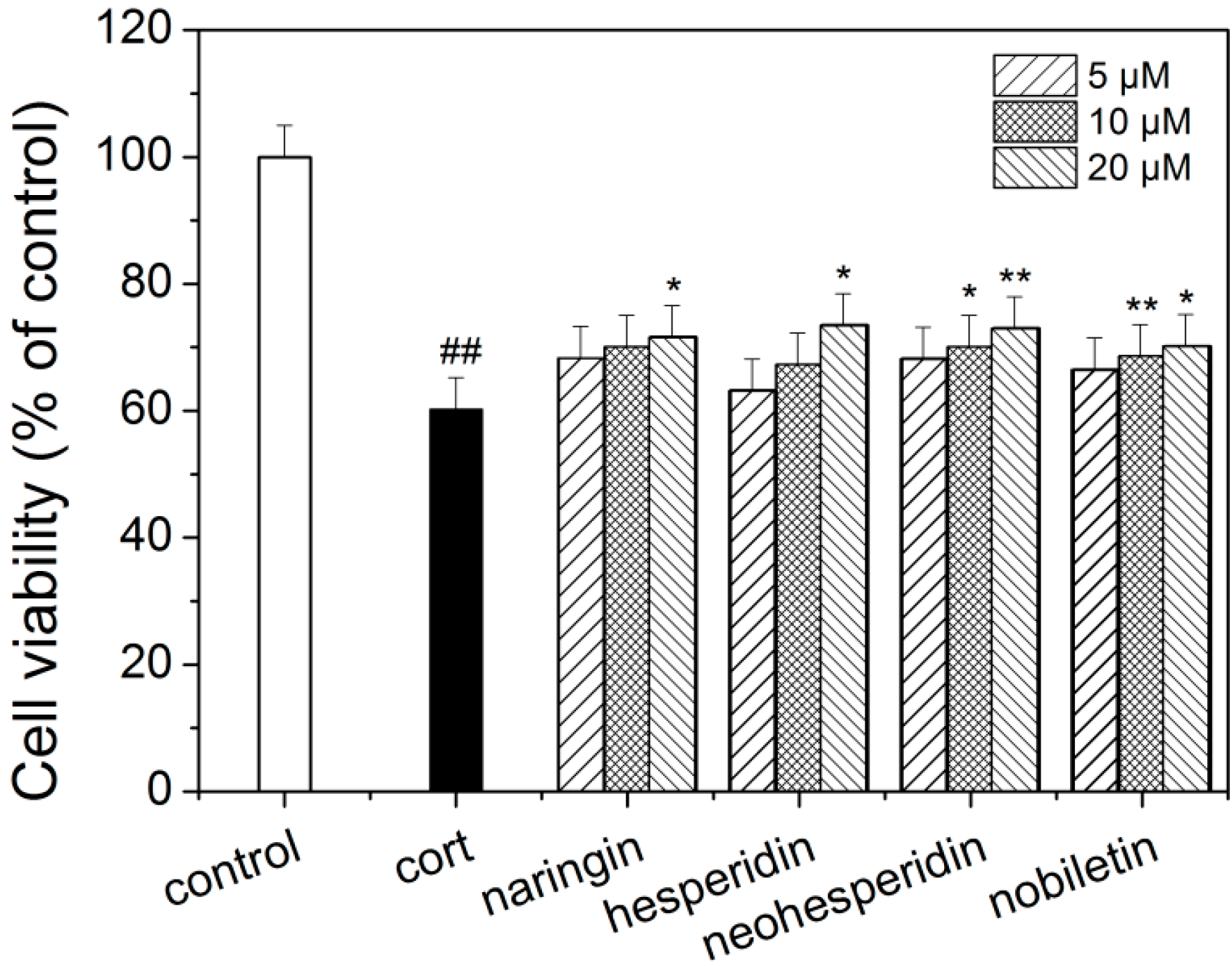
2.6. Discussion
3. Experimental Section
3.1. Chemicals
3.2. Plant Material and Sample Preparation
3.3. UPLC-Q-TOF/MS System
3.4. Animals and Treatments
3.5. Forced Swimming Test Assay
3.6. Tail Suspension Test Assay
3.7. Cell Culture and Treatment
3.8. Cell Viability Assay
3.9. Statistical Analysis
4. Conclusions
Supplementary Materials
Acknowledgments
Author Contributions
Conflicts of Interest
References
- Fugh-Berman, A.; Myers, A. Citrus aurantium, an ingredient of dietary supplements marketed for weight loss: Current status of clinical and basic research. Exp. Biol. Med. 2004, 229, 698–704. [Google Scholar]
- Committee, N.P. Pharmacopoeia of the People's Republic of China; Chemical Industry Press: Beijing, China, 2005; pp. 171–172. [Google Scholar]
- Gattuso, G.; Barreca, D.; Gargiulli, C.; Leuzzi, U.; Caristi, C. Flavonoid composition of citrus juices. Molecules 2007, 12, 1641–1673. [Google Scholar] [CrossRef] [PubMed]
- Haller, C.A.; Benowitz, N.L.; Jacob, P. Hemodynamic effects of ephedra-free weight-loss supplements in humans. Am. J. Med. 2005, 118, 998–1003. [Google Scholar] [CrossRef] [PubMed]
- Chen, H.; Zhang, W.; Yuan, J.; Li, Y.; Yang, S.; Yang, W. Simultaneous quantification of polymethoxylated flavones and coumarins in Fructus aurantii and Fructus aurantii immaturus using HPLC-ESI-MS/MS. J. Pharm. Biomed. 2012, 59, 90–95. [Google Scholar] [CrossRef]
- Steinmann, D.; Ganzera, M. Recent advances on HPLC/MS in medicinal plant analysis. J. Pharm. Biomed. 2011, 55, 744–757. [Google Scholar] [CrossRef]
- Zhou, D.; Zhang, X.; Xu, Q.; Xue, X.; Zhang, F.; Liang, X. UPLC/Q-TOFMS/MS as a powerful technique for rapid identification of polymethoxylated flavones in Fructus aurantii. J. Pharm. Biomed. 2009, 50, 2–8. [Google Scholar] [CrossRef]
- Zhou, D.; Chen, D.; Xu, Q.; Xue, X.; Zhang, F.; Liang, X. Characterization of polymethoxylated flavones in Fructus aurantii by liquid chromatography with atmospheric pressure chemical ionization combined with tandem mass spectrometry. J. Pharm. Biomed. 2007, 43, 1692–1699. [Google Scholar] [CrossRef]
- Lin, Z.; Wang, H.; Xu, Y.; Dong, J.; Hashi, Y.; Chen, S. Identification of antioxidants in Fructus aurantii and its quality evaluation using a new on-line combination of analytical techniques. Food Chem. 2012, 134, 1181–1191. [Google Scholar] [CrossRef] [PubMed]
- Sakata, K.; Hirose, Y.; Qiao, Z.; Tanaka, T.; Mori, H. Inhibition of inducible isoforms of cyclooxygenase and nitric oxide synthase by flavonoid hesperidin in mouse macrophage cell line. Cancer Lett. 2003, 199, 139–145. [Google Scholar] [CrossRef] [PubMed]
- Wang, Q.H.; Shu, Z.P.; Xu, B.Q.; Xing, N.; Jiao, W.J.; Yang, B.Y.; Kuang, H.X. Structural characterization and antioxidant activities of polysaccharides from Citrus aurantium L. Int. J. Biol. Macromol. 2014, 67, 112–123. [Google Scholar] [CrossRef] [PubMed]
- Garg, A.; Garg, S.; Zaneveld, L.; Singla, A.K. Chemistry and pharmacology of the Citrus bioflavonoid hesperidin. Phytother. Res. 2001, 15, 655–669. [Google Scholar] [CrossRef] [PubMed]
- Wu, Y.Q.; Zhou, C.H.; Tao, J.; Li, S.N. Antagonistic effects of nobiletin, a polymethoxyflavonoid, on eosinophilic airway inflammation of asthmatic rats and relevant mechanisms. Life Sci. 2006, 78, 2689–2696. [Google Scholar] [CrossRef] [PubMed]
- Jayaprakasha, G.K.; Negi, P.S.; Sikder, S.; Mohanrao, L.J.; Sakariah, K.K. Antibacterial activity of Citrus reticulata peel extracts. Z. Naturforsch. C 2000, 55, 1030–1034. [Google Scholar] [PubMed]
- Kobayashi, S.; Tanabe, S. Evaluation of the anti-allergic activity of Citrus unshiu using rat basophilic leukemia RBL-2H3 cells as well as basophils of patients with seasonal allergic rhinitis to pollen. Int. J. Mol. Med. 2006, 17, 511–515. [Google Scholar] [PubMed]
- Li, R.W.; Theriault, A.G.; Au, K.; Douglas, T.D.; Casaschi, A.; Kurowska, E.M.; Mukherjee, R. Citrus polymethoxylated flavones improve lipid and glucose homeostasis and modulate adipocylokines in fructose-induced insulin resistant hamsters. Life Sci. 2006, 79, 365–373. [Google Scholar] [CrossRef] [PubMed]
- Xu, Y.; Feng, J. Mechanism underlying the antidepressant effect of Fructus aurantii. Chin. J. Pharmacol. Ther. 2013, 1086–1092. [Google Scholar]
- Zhang, H.; Zou, Z. Application in clinic and research advances of ChaiHu-Shu-Gan-San. Lishizhen Med. Mater. Med. Res. 2007, 1234–1236. [Google Scholar]
- Jia, H.; Su, Z.; Long, W.; Liu, Y.; Chang, X.; Zhang, H.; Ding, G.; Feng, Y.; Cai, D.; Zou, Z. Metabonomics Combined with UPLC-MS Chemical Profile for Discovery of Antidepressant Ingredients of a Traditional Chinese Medicines Formula, Chaihu-Shu-Gan-San. Evid. Based Complement. Altern. Med. 2013, 2013, 487158. [Google Scholar] [CrossRef]
- Wang, C.; Pan, Y.; Fan, G.; Chai, Y.; Wu, Y. Application of an efficient strategy based on MAE, HPLC-DAD-MS/MS and HSCCC for the rapid extraction, identification, separation and purification of flavonoids from Fructus Aurantii Immaturus. Biomed. Chromatogr. 2010, 24, 235–244. [Google Scholar] [CrossRef] [PubMed]
- Matsubara, Y. Structures of New Cyclic Peptides in Young Unshiu (Citrus unshiu Marcov.), Orange (Citrus sinensis Osbeck.) Peelings. Agric. Biol. Chem. 1991, 55, 2923–2929. [Google Scholar] [CrossRef] [PubMed]
- Matsumoto, T.; Tashiro, N.; Nishimura, K.; Takeya, K. New cyclic peptides from Citrus aurantium. Heterocycles 2002, 57, 477–482. [Google Scholar] [CrossRef]
- Peng, W.; Tan, N. Cyclopeptides from Immature Fruits of Citrus aurantium. Nat. Prod. Res. Dev. 2014, 26, 1416–1420. [Google Scholar]
- Peng, W.; Lo, K.; Lee, Y.; Hung, T.; Lin, Y. Berberine produces antidepressant-like effects in the forced swim test and in the tail suspension test in mice. Life Sci. 2007, 81, 933–938. [Google Scholar] [CrossRef] [PubMed]
- Zhu, M.Y.; Wang, W.P.; Bissette, G. Neuroprotective effects of agmatine against cell damage caused by glucocorticoids in cultures rat hippocampal neurons. Neuroscience 2006, 141, 2019–2027. [Google Scholar] [CrossRef] [PubMed]
- Mao, Q.; Huang, Z.; Ip, S.; Xian, Y.; Che, C. Protective Effects of Piperine Against Corticosterone-Induced Neurotoxicity in PC12 Cells. Cell. Mol. Neurobiol. 2012, 32, 531–537. [Google Scholar] [CrossRef] [PubMed]
- Pathak, L.; Agrawal, Y.; Dhir, A. Natural polyphenols in the management of major depression. Expert Opin. Investig. Drugs 2013, 22, 863–880. [Google Scholar] [CrossRef] [PubMed]
- Herrera-Ruiz, M.; Zamilpa, A.; Gonzalez-Cortazar, M.; Reyes-Chilpa, R.; Leon, E.; Garcia, M.P.; Tortoriello, J.; Huerta-Reyes, M. Antidepressant effect and pharmacological evaluation of standardized extract of flavonoids from Byrsonima crassifolia. Phytomedicine 2011, 18, 1255–1261. [Google Scholar] [CrossRef] [PubMed]
- Donato, F.; de Gomes, M.G.; Goes, A.; Borges, C.; Del Fabbro, L.; Antunes, M.S.; Souza, L.C.; Boeira, S.P.; Jesse, C.R. Hesperidin exerts antidepressant-like effects in acute and chronic treatments in mice: Possible role of L-arginine-NO-cGMP pathway and BDNF levels. Brain Res. Bull. 2014, 104, 19–26. [Google Scholar] [CrossRef] [PubMed]
- Yi, L.T.; Xu, H.L.; Feng, J.; Zhan, X.; Zhou, L.P.; Cui, C.C. Involvement of monoaminergic systems in the antidepressant-like effect of nobiletin. Physiol. Behav. 2011, 102, 1–6. [Google Scholar] [CrossRef] [PubMed]
- Su, Z.; Li, S.; Zou, G.; Yu, C.; Sun, Y.; Zhang, H.; Gu, Y.; Zou, Z. Urinary metabonomics study of anti-depressive effect of Chaihu-Shu-Gan-San on an experimental model of depression induced by chronic variable stress in rats. J. Pharm. Biomed. 2011, 55, 533–539. [Google Scholar] [CrossRef]
- Porsolt, R.D.; Bertin, A.; Jalfre, M. Behavioral despair in mice: A primary screening test for antidepressants. Arch. Int. Pharmacodyn. Ther. 1977, 229, 327–336. [Google Scholar] [PubMed]
- Steru, L.; Chermat, R.; Thierry, B.; Simon, P. The tail suspension test: A new method for screening antidepressants in mice. Psychopharmacology 1985, 85, 367–370. [Google Scholar] [CrossRef] [PubMed]
- Gao, M.; Zhou, H.; Li, X. Curcumin Protects PC12 Cells from Corticosterone-Induced Cytotoxicity: Possible Involvement of the ERK1/2 Pathway. Basic Clin. Pharmacol. 2009, 104, 236–240. [Google Scholar] [CrossRef]
- Samples Availability: Samples of Zhi-Qiao are available from the authors.
© 2015 by the authors. Licensee MDPI, Basel, Switzerland. This article is an open access article distributed under the terms and conditions of the Creative Commons Attribution license ( http://creativecommons.org/licenses/by/4.0/).
Share and Cite
Wu, M.; Zhang, H.; Zhou, C.; Jia, H.; Ma, Z.; Zou, Z. Identification of the Chemical Constituents in Aqueous Extract of Zhi-Qiao and Evaluation of Its Antidepressant Effect. Molecules 2015, 20, 6925-6940. https://doi.org/10.3390/molecules20046925
Wu M, Zhang H, Zhou C, Jia H, Ma Z, Zou Z. Identification of the Chemical Constituents in Aqueous Extract of Zhi-Qiao and Evaluation of Its Antidepressant Effect. Molecules. 2015; 20(4):6925-6940. https://doi.org/10.3390/molecules20046925
Chicago/Turabian StyleWu, Ming, Hongwu Zhang, Chao Zhou, Hongmei Jia, Zhuo Ma, and Zhongmei Zou. 2015. "Identification of the Chemical Constituents in Aqueous Extract of Zhi-Qiao and Evaluation of Its Antidepressant Effect" Molecules 20, no. 4: 6925-6940. https://doi.org/10.3390/molecules20046925
APA StyleWu, M., Zhang, H., Zhou, C., Jia, H., Ma, Z., & Zou, Z. (2015). Identification of the Chemical Constituents in Aqueous Extract of Zhi-Qiao and Evaluation of Its Antidepressant Effect. Molecules, 20(4), 6925-6940. https://doi.org/10.3390/molecules20046925





